2022 is coming to an end and before you know it 2023 will soon be here, and with the arrival of a new year also appears the excitement regarding new promotional campaigns for your brand. But before you get to that, how about a quick content audit for 2022 to check the results of your content efforts from this year?
There’s no better way to start a new campaign than based on the results of an SEO content audit data because, from all the experiments you ran throughout the year, you’ll be able to replicate the strategies that worked and eliminate the ones that didn’t.
There’s no single score that can tell you whether your efforts were fruitful or not, this is why a search engine optimization audit uses various content audit tools (like SemRush’s content audit tool, Ahref’s, MOZ, etc.) to analyze the whole campaign and help you eventually improve the quality of your content which will lead to improved traffic.
So, this article will simplify it for you and leave you with a better understanding of the whole purpose of a content audit and why it’s important, especially now.
Let’s Make Your SEO & Content Work Better for Your Business
Content Audit Definition and Why Is a Content Audit Useful
In very simple terms, it’s the process of tracking down all content produced by your campaign or company, or brand and organizing it to find out what worked and what failed. A much deeper content audit definition would be the process of obtaining a detailed overview of all content, following a comprehensive analysis using performance metrics from a variety of sources to determine which one is going to be improved, removed, or retained as is.
Generally, it’s the only way to discover the options that will improve the overall quality of your site and in turn improve rankings and conversion rates. It also gives a boost to your SEO and content marketing efforts.
Here are 4 main reasons why you need an SEO content audit:
1. Identify What’s Working and What’s Not
As you already know, not all your content gets the same response, some will be a huge hit and others will just fill the space. So, how will you know which content thrived and which one was missed? By going through each of them, if you don’t do this, you might end up wasting so much time, effort, and money on dysfunctional content and campaign strategies.
2. Goals and Objectives
How good is your content from the point of view of achieving its objectives? Are you raking up any ROI? A content audit is the only way to track your content’s performance in terms of lead generation and conversions.
3. Update! Update! Update!
As time goes on, many changes impact the tech and marketing world. So, yesterday’s data and insights might not be useful today. And that’s valid for content as well: facts and data need accuracy and these changes very often lately. Running an audit ensures your content is updated and as relevant as possible to your audience.
4. Website Performance
Another key thing is to measure how friendly your website is to search engines and gauge how smooth it is for your users to navigate through it and its speed. The UX content audit has to be done to check the robustness of your website’s technical framework and infrastructure. A good starting point is to test your site with a tool like PageSpeed Insights or GTMetrix, to have a clear overview of all aspects that impact your site’s performance.
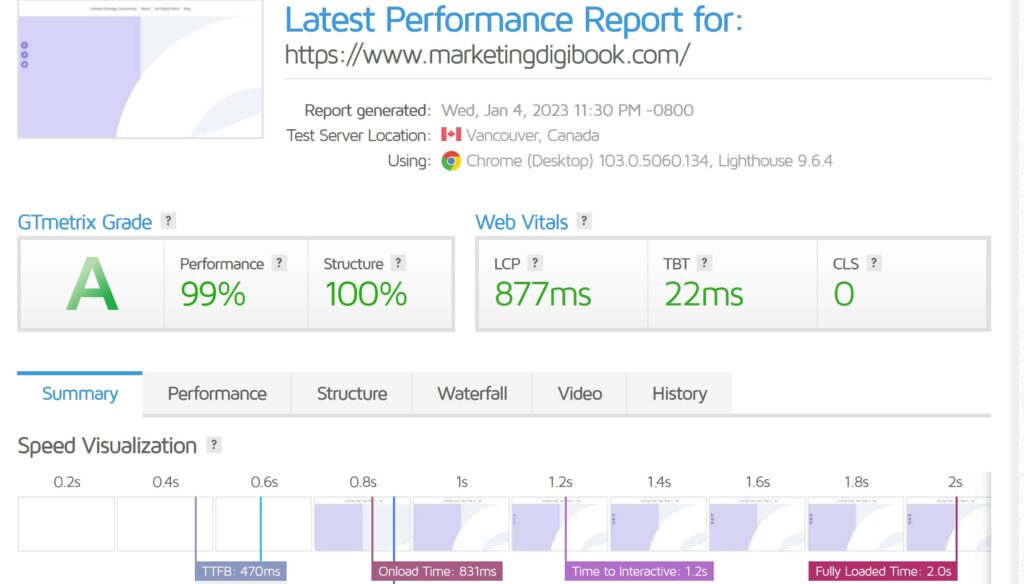
Who Should Do a Content Audit?
Generally, the age and size of your site determine whether you need a content audit and how detailed it should be. A fairly new site may not require a content audit yet. However, if your site has been around for some time and has some old or outdated content, you may want to re-evaluate it to see whether it still aligns with the current status of your business.
Having established all the above information, the next question appears:
How Do You Go About Conducting a Content Audit?
Check the image below to find some Content Audit Strategies valid for the most common cases:
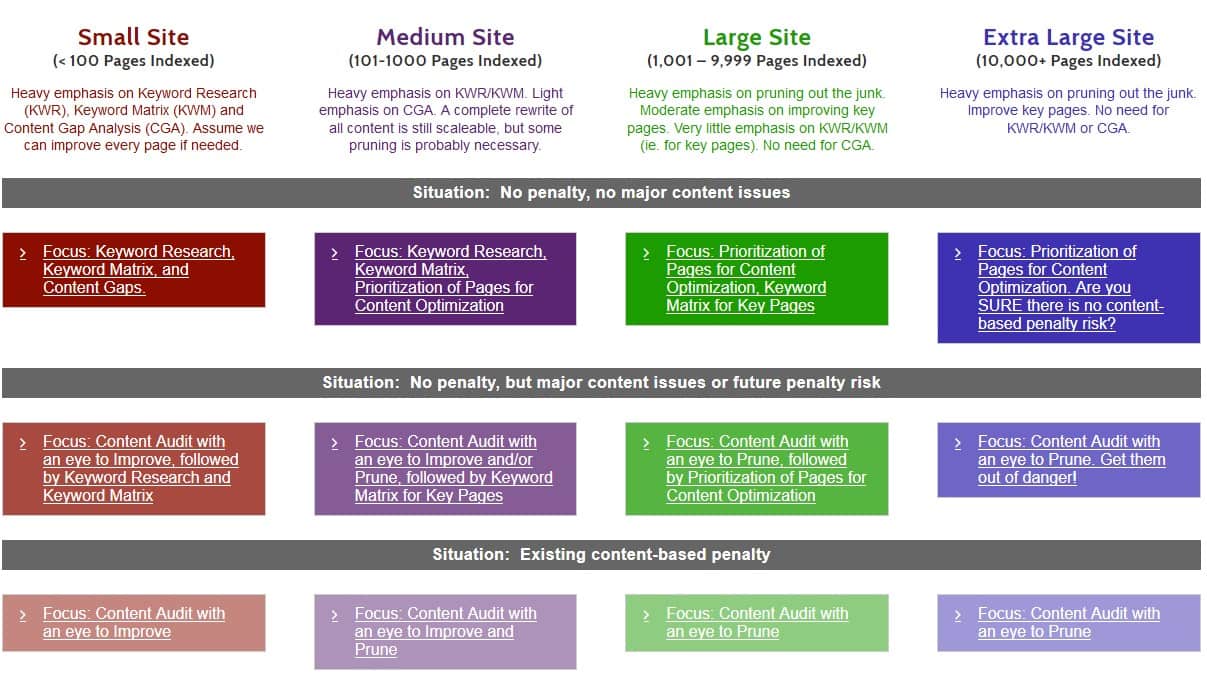
Source: Goinflow
Here is how:
The process of a website content audit starts by registering all your content available for indexation in search engines. It is then analyzed through a variety of metrics. The actions taken after this analysis differs depending on your strategy or site.
The process can be divided into the following phases;
- Content Inventory and Content Audit
- Analysis and recommendations
- Summary and reporting
A. Content Inventory and Content Audit
This phase starts by crawling your site and listing in a file all its content and all related metrics. Here are the metrics you’ll want to track for your content audits:
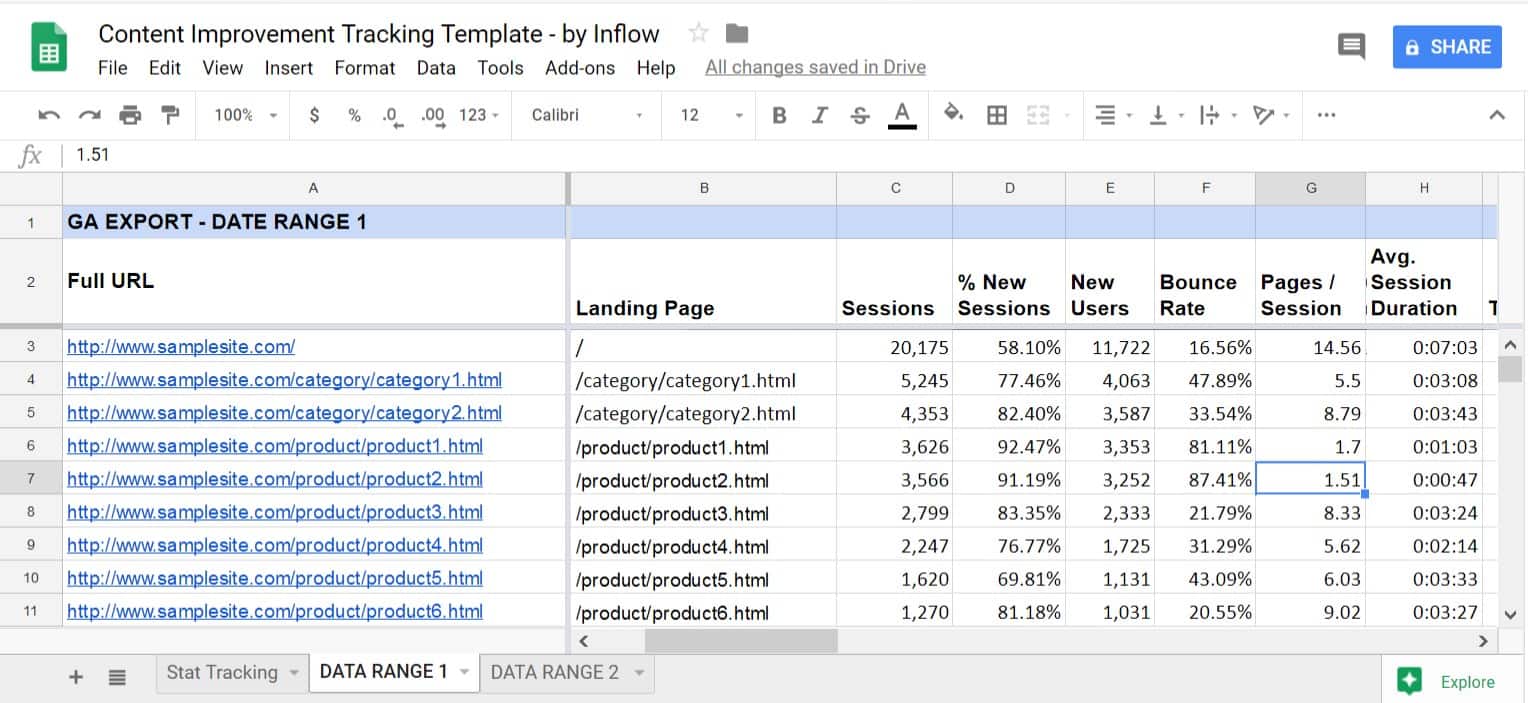
Source: Inflow
Metrics You’ll Want to Track
Organic Traffic
The whole idea of any content is to organically gain traffic, but this isn’t always the case. And therefore, it is of utmost importance to check your content strategy, your distribution channels, and the content itself.
Evaluating the organic traffic for each piece of content will offer you valuable information on your audience’s preference and which topics are of interest to her. And also, you will have the chance to identify which pieces of content do not perform and find out the proper explanation for this. Check your Google Analytics and Google Search Console reports to gather the necessary insights.
Backlinks
Backlinks are great to reinforce your domain authority, but some of them can be hazardous. Through auditing your content regularly, you will manage to identify and get rid of the dangerous ones that can affect your rankings. You can check on your backlinks with a free tool like Ahref’s Backlink checker.
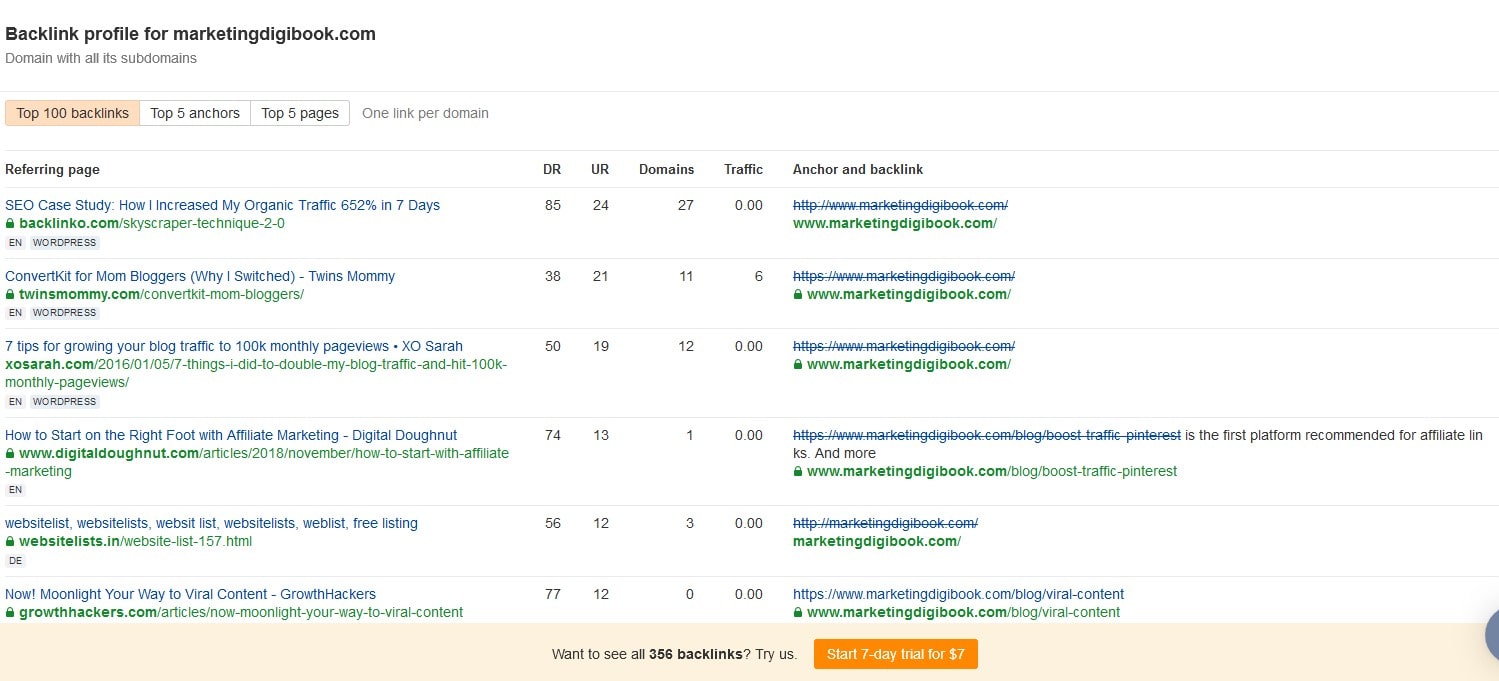
Bounce Rate
Ideally, your content should lead a user from a search engine to your site where they will get more information as they navigate to the rest of your website, but if this isn’t the case, then it’s an indicator that there’s something wrong with your content.
Time Spent on Page
Depending on the type of your content, whether long or short form, by looking at the average time spent you will know if your content is right for your audience or not. For instance, if you have a long blog post of about 2500 words but the average time spent is 30 seconds, then this shows something is not right.
Pages Views Per Session
It’s also important to find what pages the users visited while they were on your website. This can offer you ideas and insights on how to improve your content in the future.
New and Returning Users
A returning user probably means you did something right, if they’re not a customer yet, they’re near to becoming one. But a new user is also a great thing! Therefore, your primary purpose should be to retain as many as possible of existing customers and gain more and more new ones.
Your Main Sources of Traffic
Pinpoint your main sources of traffic. If for instance, your largest flow of traffic is from Pinterest, then it will require you to post there more.
In general, the above metrics will give you insights into user behavior, engagement, SEO, and sales.
Steps of the Content Audit Process:
1. Collect the URLs and Their Meta Descriptions
So, first, you need to collect all the URLs of the pages of your site you want to audit and list them all in a content audit spreadsheet. To make it easier for you, you can use a content audit tool from a plethora of tools available such as Ahrefs, Google Analytics, SEMRush, and many more.
These tools will easily audit your content based on your site map data and also list for you the web pages that are important to you. In case you don’t have a sitemap, you can use a sitemap generator tool like XML Sitemaps generator to create one for your website. Having a sitemap goes beyond facilitating a content audit, it enables search engines to understand the organization of your website and brings up all the important pages.
2. Categorize Your Content
After you’ve collected your URLs, you now need to categorize them into the following categories:
- Author (if the case – when you have more authors or more teams creating content)
- Content type e.g. web pages, landing pages, blog posts, ebooks, etc.
- Meta description
- Date of publication or last editing (helps identify stale data)
- Content format (text, images, videos)
- Customer’s Journey Stage (awareness, consideration)
- Main keyword
- And the number of words
After categorizing all your content, organize all the information in a dashboard that can automatically generate a list of URLs using a tool like Screaming Frog, or create columns (using content audit spreadsheets) with your metrics to gather data for each web page. And before the very next stage of analysis, save yourself some headaches by removing any unwanted data, these may include:
- Blank columns
- Single value columns
- Duplicate columns
- Meta-keywords
B. Analysis and Recommendations
This is the second phase and here is the place you start to make sense of all the hard work you have been putting in. The goal of this entire procedure is to identify gaps and weak points, as well as the strengths of your content in order to build on them and improve on the weaknesses.
The content issues to evaluate in this phase can be put into these categories:
- Relevance – Very old content that’s no longer valid.
- Quality – Awfully written articles e.g. keyword bloated articles or simply inaccurate data.
- Duplication – Internally repeated on other pages or externally e.g. through Review comparisons.
Remember the metrics discussed earlier? Well, this is where they come into play. Here they will help you evaluate the data and define a clear course of action with respect to what your content audit says.
The easiest way to start your analysis is by creating two columns next to each URL. One column is for labelling the actions and the next column is to list notes.
Here are some guidelines:
New Content
Leave this out because it needs some time to gain traction and make some sense.
Impressions
If you get a high rate of impressions from GSC, perhaps the metadata (title tag & meta description) and content should be improved. Label it “improve”
Page Views
Use your most valuable metric to filter your data, for instance: traffic or time on the page. You could start focusing on pages with fewer than 70 views.
Status Codes
Let the URLs that you’re looking through have a status code of at least 200.
Social Shares
Exclude URLs with a large number of social shares.
Objective Completions
Consider the number of objectives that are completed by each page and leave out any pages that are converting.
Backlinks
Redirect any backlinks or referring domains to similar pages and label that action as “Redirect” then note that under the notes list in your column.
Keywords
If you have articles with a big number of keywords from the analysis, label this as “improve”
Thin Content
You may have several pages with very thin or similar content; you can merge these together and then label them “consolidate”. You can also consolidate pages with similar topics or duplicate content.
Rewrite
Rewrite important pages such as the home page or the page with top products, pages with good links and social metrics, and pages with good traffic. Label “Rewrite/Update”
Remove
Now if there’s anything else left after this, label it as “remove”.
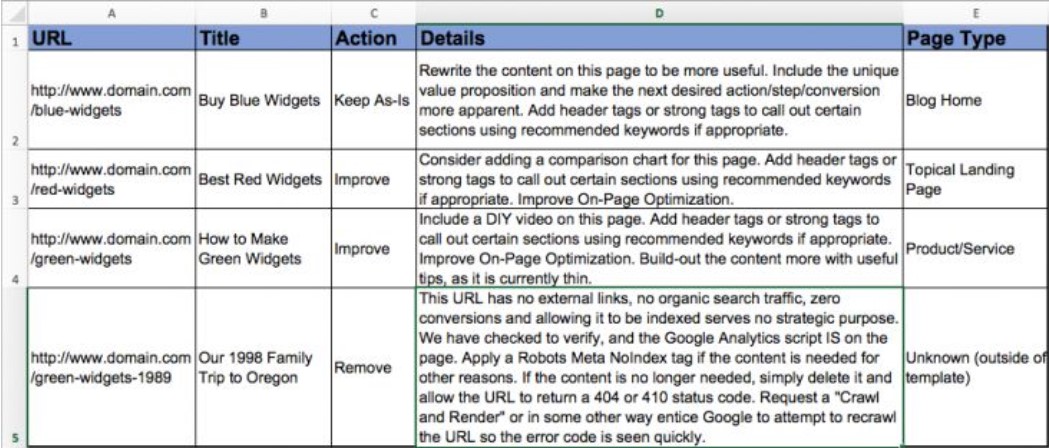
Source: MOZ
C. Summary/Action Plan and Reporting
With your analysis completed, your next steps of action should be to carry out your action plans based on your objectives or goals. It should include how you intend to recreate your best-performing content as well as improve all underperforming content to be able to meet up expectations and your targets.
Here are a few actionable tips that you can follow:
Update your Calls to Action; Replace your old campaign content with something fresh and relevant to reignite your content marketing funnel that will eventually improve your conversion.
Re-use your content; recreate your pieces of content and try publishing them in different formats for a change.
Add images and videos; Videos can drive up to 200% organic traffic to your site. Therefore, make your content more captivating by integrating videos and images and you will see the traffic soaring.
Optimize your internal links; reduce bounce rates by adding internal links to new and relevant content.
Generally, align your website by avoiding common SEO mistakes and thus give your users a smooth experience. You can also take advantage of Google Search Console to update Google about your newest content.
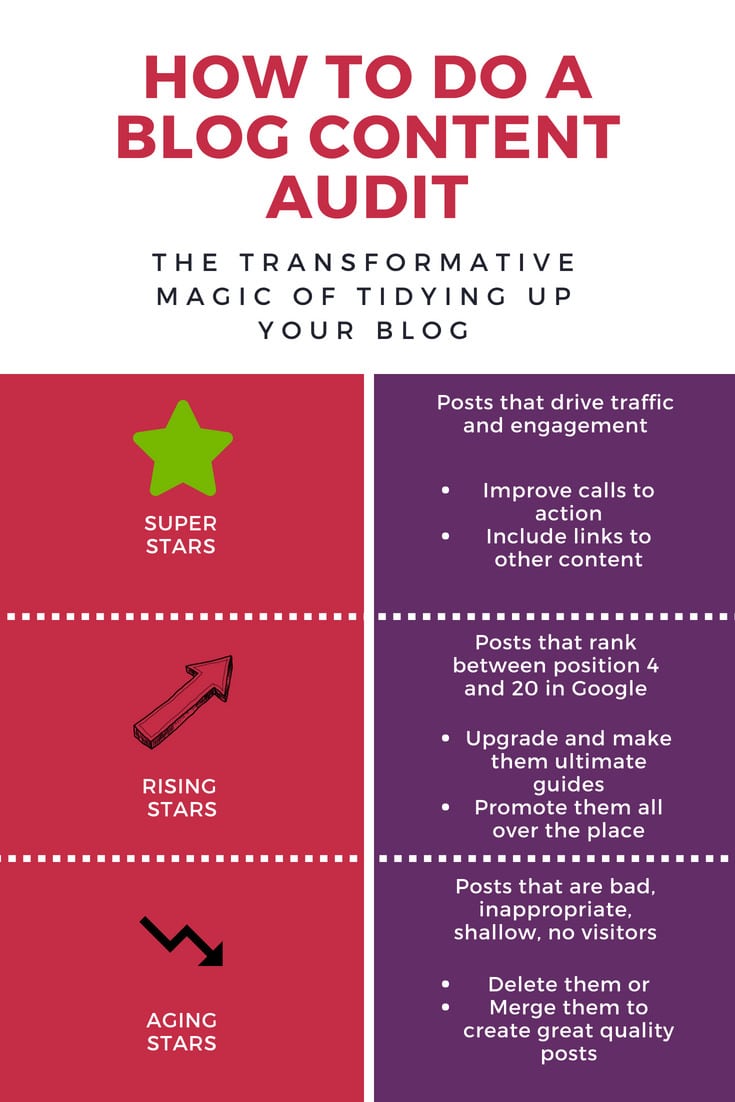
Source: Howtomakemyblog
Having gotten to this point, you’re now able to see whether your content is hitting the target or absolutely missing it.
For the high-performing content, make note of the content details audit, consider what the topic was, who produced it and the time it was published.
Replicating your success strategy can definitely help you create similar high-performing content. But for the ones that don’t make a hit, consider also noting the channels used, at times it’s not the content that is the problem, but rather a blend of issues such as the producer of the content, time of publishing, or the content type.
Final Thoughts
Going forward, the content audit doesn’t just stop here, a deliberate effort of keeping low-quality content away from Google’s index must be a continuous process.
There’s also no one-fits-all strategy or content audit template that you must follow always or that works for everyone; rather, audits can vary in type, size, scope, or approach. The key thing is how relevant is it to your goals and how it helps you improve your results
It is recommended to stay creative and logical while conducting your audit and come up with the most appropriate solutions that will improve your overall content strategy.






